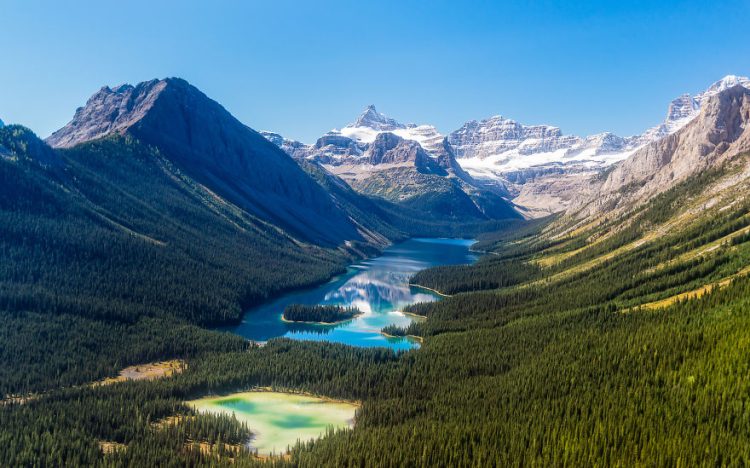In the vast land of North America, there is a majestic mountain range, the Canadian Rockies. It is not only one of the most spectacular natural landscapes in North America, but also an important pillar of Canada’s national geography, economic development and ecological protection. Starting in northern British Columbia and extending south to Alberta, the Rocky Mountains attract the world’s attention for their lofty stature, varied landscapes and abundant natural resources. This paper will deeply discuss the geographical location, topography, geomorphology, climate characteristics and other basic information of the Canadian Rockies, analyze its role and significance in national geography, economic development, ecological protection and other aspects, elaborate the current challenges and threats, and put forward suggestions and measures for protection and sustainable development.
Basic information about the Canadian Rockies
1.1 Geographical Location
The Canadian Rockies is the general term for the North American Rockies in Canada, from British Columbia in the north to Alberta in the south, a total length of about 1600 kilometers, is an important natural barrier in western Canada. This mountain range not only separates the inland from the coastal areas, but also constitutes an important watershed of the North American continent, and many great rivers such as the Columbia River and the Yukon River originate here.
1.2 Topography and Landforms
The Canadian Rockies are complex and diverse, with rich geomorphic features. There are towering snow peaks and vast meadows; There are deep and quiet canyons, as well as gurgling streams. Mountains are mainly made up of ancient rocks, which have undergone geological changes and weathering over eons of time to form the magnificent landscape we see today. Among them, Mount Robson has become the highest peak of the Canadian Rockies with an altitude of 3954 meters, while others such as Mount Chaffee and Mount Assiniboine also have their own characteristics and are breathtaking.
1.3 Climate Characteristics
The Rocky Mountains are located in the northern margin of the North American tropical climate zone, with diverse climate types and significant vertical zonation. Summer is warm and dry, winter is cold and wet, the average annual temperature is low, and precipitation is mainly concentrated in summer. The high elevations are covered with snow and glaciers, adding mystery and grandeur to the mountains. This unique climatic condition not only breeds rich biodiversity, but also provides good natural conditions for a variety of outdoor activities.

The role and significance of the Rocky Mountains in Canada
2.1 National Geographic symbol
The Canadian Rockies are not only an important boundary in physical geography, but also a symbol of Canadian National Geographic. It has witnessed Canada’s transition from wilderness to civilization, carrying rich historical and cultural connotations. For Canadians, the Rockies are not only a mountain range, but also a spiritual sustenance and cultural identity.
2.2 Engine of economic development
The rich natural resources of the Rocky Mountains provide a strong impetus for Canada’s economic development. It is rich in mineral resources, such as gold, copper, coal, etc., which has played an important supporting role in Canada’s industrial development. Tourism is also an important economic pillar of the Rocky Mountain region. Every year, it attracts millions of tourists from all over the world to come for sightseeing and brings considerable economic income to the local area. In addition, agriculture, forestry and other industries are thriving in the Rocky Mountain region.
2.3 Model of ecological protection
The Canadian Rockies have a unique ecological environment and are home to many rare animals and plants. This is not only the source of North America’s rivers, but also the last refuge for many endangered species. Therefore, protecting the ecological environment of the Rocky Mountains is of great significance to maintaining the global ecological balance. The Canadian government has been committed to the ecological protection of the Rocky Mountains, through the establishment of national parks, nature reserves and other measures to effectively protect the ecological environment and biodiversity in this region.
Challenges and threats to the Rocky Mountains
3.1 Climate Change
As global warming intensifies, the Rocky Mountains are facing serious climate change challenges. Increasingly serious phenomena such as melting glaciers, rising snow lines and frequent extreme weather events not only threaten the balance and stability of the ecosystem, but also pose a potential threat to local water resources security. In addition, climate change is likely to cause more frequent natural disasters, such as mountain fires and floods, which will have a serious impact on local people and the ecological environment.
3.2 Tourism Development
The growth of tourism has brought economic prosperity to the Rocky Mountain region, but it has also brought ecological pressure. Overdevelopment and irrational use have resulted in the destruction of some natural landscapes and the threat of biodiversity. At the same time, the influx of tourists has also put higher demands on local infrastructure and public services. How to promote the sustainable development of tourism under the premise of protecting the ecological environment has become an urgent problem to be solved.
3.3 Exploitation of mineral resources
The exploitation of mineral resources is one of the important support points for the economic development of the Rocky Mountains, but it also brings ecological and environmental risks. Mining activities can pollute soil, water and air, disrupting the balance and stability of local ecosystems. Therefore, in the process of mineral resources development, environmental protection laws and standards must be strictly observed, and scientific and reasonable mining methods and technical means must be adopted to reduce the negative impact on the ecological environment.
Recommendations and measures for the protection and sustainable development of the Rocky Mountains
4.1 Strengthen policy guidance
The government should strengthen policy guidance and support for ecological protection and sustainable development in the Rocky Mountain region. Formulate and improve relevant laws, regulations, policies and measures, and clarify the main responsibility and supervision mechanism of ecological protection; Increase investment and policy support for ecological protection projects; Encourage and support all sectors of society to participate in ecological protection work to form a good atmosphere for the whole society to pay attention to and support ecological protection.
4.2 Promote green development
In the process of economic development in the Rocky Mountain region, we should adhere to the concept of green development, promote industrial transformation and upgrading, and green and low-carbon development. Encourage and support the development of green industries such as clean energy, energy conservation and environmental protection; Strengthen scientific and technological innovation and technology research and development, improve resource utilization efficiency, reduce energy consumption and emissions; Promote the concept of green consumption to guide the public to build awareness of saving resources and protecting the environment.

4.3 Raise public awareness of environmental protection
The improvement of public environmental awareness is an important basis for protecting the ecological environment of the Rocky Mountains. The government and all sectors of society should strengthen the publicity and education of public environmental protection knowledge to improve the public’s understanding and attention to ecological protection; Encourage and support the public to participate in environmental protection activities and voluntary service work to form a good situation of the whole society to participate in ecological protection; Strengthen environmental education for young people to cultivate their environmental awareness and responsibility from an early age.
4.4 Strengthen international cooperation and exchanges
The Rocky Mountains straddle the border area of Canada and the United States, involving the interests of many countries and regions, so strengthening international cooperation and exchange is of great significance to protect the ecological environment of the Rocky Mountains. Countries should strengthen information sharing and resource complementarity to jointly formulate protection policies and action plans; Strengthen scientific research cooperation and technological exchanges to jointly address climate change and other global challenges; Strengthening cross-border cooperation and policy coordination to promote sustainable development in the Rocky Mountain region.
V. Conclusion
The Canadian Rockies, with their magnificent natural scenery and rich natural resources, are among the treasures of the World Natural Heritage. However, in the face of multiple challenges and threats such as climate change, tourism development and mineral resource development, it is difficult and urgent to protect the ecological environment of the Rocky Mountains and achieve sustainable development. Only through strengthening policy guidance, promoting the concept of green development, raising public awareness of environmental protection, and strengthening international cooperation and exchanges can we ensure the effective protection of the ecological environment of the Rocky Mountains and make greater contributions to the sustainable development of human society.





















